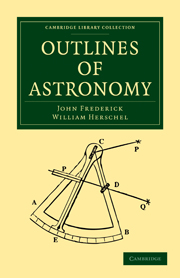CHAPTER XIV
Published online by Cambridge University Press: 05 July 2011
Summary
(702.) To calculate the actual place of a planet or the moon, in longitude and latitude at any assigned time, it is not enough to know the changes produced by perturbation in the elements of its orbit, still less to know the secular changes so produced, which are only the outstanding or uncompensated portions of much greater changes induced in short periods of configuration. We must be enabled to estimate the actual effect on its longitude of those periodical accelerations and retardations in the rate of its mean angular motion, and on its latitude of those deviations above and below the mean plane of its orbit, which result from the continued action of the perturbative forces, not as compensated in long periods, but as in the act of their generation and destruction in short ones. In this chapter we purpose to give an account of some of the most prominent of the equations or inequalities thence arising, several of which are of high historical interest, as having become known by observation previous to the discovery of their theoretical causes, and as having, by their successive explanations from the. theory of gravitation, removed what were in some instances regarded as formidable objections against that theory, and afforded in all most satisfactory and triumphant verifications of it.
(703.) We shall begin with those which compensate themselves in a synodic revolution of the disturbed and disturbing body, and which are independent of any permanent excentricity of either orbit, going through their changes and effecting their compensations in orbits slightly elliptic, almost precisely as if they were circular.
- Type
- Chapter
- Information
- Outlines of Astronomy , pp. 454 - 518Publisher: Cambridge University PressPrint publication year: 2010First published in: 1864

